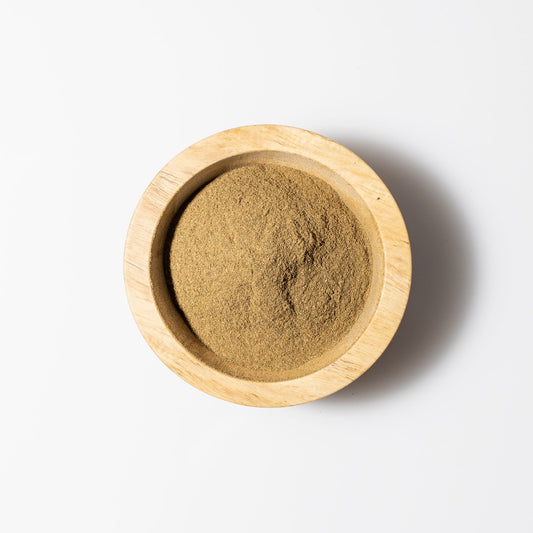We at Banyan LOVE brahmi/gotu kola. If you were to stop in and visit us, you would find this herb all around our office—bottles of Mental Clarity, Brahmi tablets, Focus liquid extract, Nasya Oil, Stress Ease, 7-Herb Energy, and so many other products containing brahmi/gotu kola can be found at our desks to help us stay at our peak performance and feeling balanced.
Brahmi/gotu kola helps us stay cool, calm, and grounded, and it helps us concentrate and stay on task. And when we are looking to support our memory (always), strengthen our nervous system, heighten our consciousness, and awaken our crown
Gotu Kola in the Landscape
This small, water-loving creeper has slender stems and leaves that gently curl in, creating small conical shapes. In fact, “gotu kola” is Sinhalese for “cone leaf.”2 This plant is not to be confused with its close friend, bacopa (with the botanical name of Bacopa monniera). These two plants have such a deep connection that both have been named brahmi, which certainly is cause for confusion.
To keep it clear in this blog, we are talking about Centella asiatica, and we will simply call it gotu kola.
| The Names of Centella asiatica | ||||
| Brahmi | Derived from “Brahman;” some of the many translations include: energy of consciousness, the greatest of the great, and God-consciousness | |||
| Gotu kola | Sinhalese for “conical shape” | |||
| Mandukaparni | Sanskrit for “frog-leaved” | |||
| Tiger herb | This comes from the legend in which tigers roll in gotu kola when wounded to help them heal | |||
Gotu kola spreads, creating a veritable carpet of vibrant green. That spreading nature is the reason it can be found on almost every continent, making it as ubiquitous in some parts of the world as dandelions are to us in North America. In fact, it is so commonplace in some environments that it has even been labeled a weed.
While gotu kola is thought to have originated on the Indian subcontinent, it has also naturalized itself to the warmer areas of Africa, Asia, parts of Australia, Central America, and in places within the United States. It loves hot, wet areas and boggy soil, and as long as it has those growing conditions, gotu kola isn't too particular about where it grows.
In fact, this herb can be found filling in the cracks in pavement, lining wet ditches, and gathering around water pumps—and chances are, it will be in any other place with heat and a damp, semi-aquatic environment. This “easy-going” nature makes it suitable for cultivation. We're even growing it in our Oregon garden at the Banyan offices!
While we're talking about gotu kola's laissez faire attitude toward its growing conditions, it is important to ensure your gotu kola is sourced from a reputable, cultivated harvest. Just as plants will take in nutrients from the soil and water, so too will they absorb contaminants, and many of the areas where gotu kola grows wildly can be quite polluted. If you would like to learn more about our gotu kola sources, check out this article on growing brahmi/gotu kola.

Reading the Leaves
Taking a look at a gotu kola leaf, we can see how it may have inspired another of the plant's common names. The Sanskrit name for gotu kola is mandukaparni, or “frog-leaved,” and not surprisingly, the leaves are reminiscent of the webbed feet of a frog.3 Plus, like frogs, this low growing plant loves wet and boggy environments.
The leaves look like a cerebellum too, representing one of the best examples of the doctrine of signatures—a fascinating idea, although not necessarily Ayurvedic, that says herbs affect the part of the body that they resemble. In this case, we have the rather apparent hint from the leaves that gotu kola has an affinity for the brain.4
Ancient Roots: Gotu Kola in Folklore and Classical Texts
Gotu kola has spread its way into the folklore of several cultures, all of which highlight gotu kola's power to enhance the intellect, enrich the mind, and increase longevity. For example, in the folklore of Sri Lanka, the deep memories and long lives of elephants are attributed to their favorite snack—gotu kola.5
In another story, the Tai Chi Chuan master, Li Ching-Yun, credited his long life to the herbs he incorporated into his routine, which included gotu kola. As implausible as it may sound, he is reported to have lived to the old age of 256!6 We aren't here to prove or disprove this, but even if this story is hyperbole, its message is still valid (take your herbs!).
In the Ayurvedic realm, gotu kola is referenced in the Shushruta Samhita and the Charaka Samhita, the two most foundational and authoritative ancient texts on Ayurvedic medicine. As a known rejuvenative, gotu kola is recorded in the ancient passages that discuss
One such preparation with gotu kola, for example, will “give a favorable turn to one's fortune, impart a lotus-like bloom [to the cheeks] with perpetual youth, unparalleled intellectual faculties, and a life that would cover a period of three centuries of song and sunshine.”7
Another preparation, after continuous use for seven days, “improves memory, intellect, and imparts a celestial glow to the complexion.” And after two additional weeks, among other benefits, it will “remove all inauspicious features” of the body and the mind—and this person will now be able to live for 500 years.8 (Li Ching-Yun now seems young!)
(Taking a preparation with gotu kola will...)
“...give a favorable turn to one's fortune, impart a lotus-like bloom with perpetual youth, unparalleled intellectual faculties, and a life that would cover a period of three centuries of song and sunshine.”
Gotu Kola in the Body, Mind, and Spirit
The rejuvenative quality of gotu kola is responsible for more than just those grandiose anecdotes and impressive references to longevity. Gotu kola is known to help rejuvenate the mind and optimize brain function, and some Ayurvedic texts say that gotu kola rejuvenates the whole life!9
As a tridoshic herb, gotu kola can bring support to all the
In particular, gotu kola brings these actions to the brain, making it the perfect herb to support a healthy mind, and promote concentration, memory, and intelligence.13 Gotu kola certainly lives up to its name as “the friend of the brain!”
It also lives up to its name as “the herb of enlightenment.” Through the cleansing, nourishing, and tonifying in the mind and nervous system, we are able to experience greater awareness and a more open and activated crown chakra. Knowing this, it is no surprise that gotu kola is often used to improve meditation.14
Gotu kola is also a recognized adaptogen,15 making this a wonderful herb to help the body cope in times of stress by helping to relax the nervous system and calm the emotions, essentially reducing and removing stress from the body, mind, and spirit. Because gotu kola helps the body cope with stress and improve circulation, the benefits often extend to the physical appearance.
Gotu kola is commonly used in skin care regimes because it promotes a clear complexion and healthy skin, and it is frequently used in hair products to support the health of the scalp and thick lustrous hair.

Incorporating Gotu Kola into Your Routine
Thanks to all that gotu kola bestows upon us, it can be found in so many Ayurvedic formulas, and it can be easy to incorporate into your daily routine. Fresh gotu kola juice is considered the strongest way to use it. The fresh leaves also make a great addition to salads; in fact, in several parts of the world, gotu kola is considered a salad green.
If fresh gotu kola isn't an option, powdered gotu kola can still be quite effective when taken by itself with warm or room temperature water; hot water generally isn't recommended with gotu kola as it can destroy its properties.16 Brahmi tablets are another option.
If you're looking for a ready-made formula with gotu kola, you can find it in a whole slew of Banyan products, from Mental Clarity, Tranquil Mind, and Focus, to our Healthy Skin, Healthy Hair, Healthy Pitta, Healthy Vata, our women's formulas, some of our oils—and more!
We have mentioned quite the list of ways to call upon gotu kola to help achieve balance—and yet, we didn't even cover all the ways it can support health and wellness. How is it possible for one little herb to accomplish so much?! We're a bit baffled by this, but what else would you expect of the “herb of enlightenment?”









